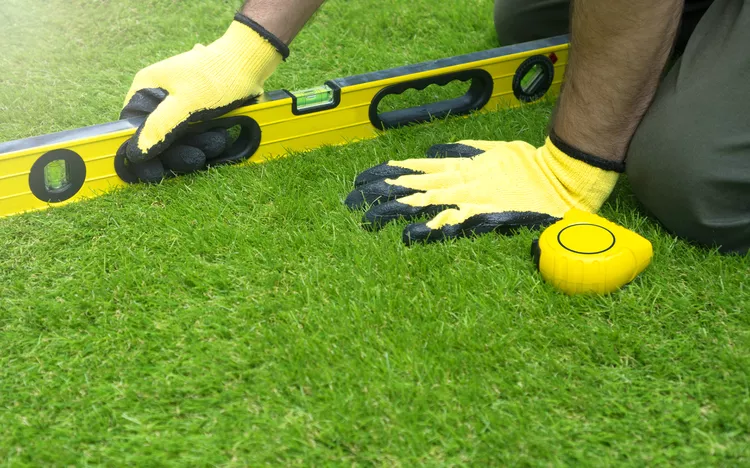How to Level a Yard by Removing Bumps and Divots

A yard is ideal for playing games, hosting a barbecue, or simply relaxing in the warmth of the sun. However, it also has a vital role when it comes to drainage. If a yard is not graded correctly or leveled, water from rain and melting snow may flow back toward the home’s foundation, where it can cause damage to the concrete and seep through the walls into the basement.
With this in mind, it’s essential to ensure a yard is level to protect your home. Additionally, poor leveling can damage gardens, trees, and landscaping. Divots and dents can lead to standing water, an ideal location for mosquitoes and other pests to reproduce. Avoid these problems by learning how to level a yard with this straightforward guide.
Importance of Having a Level Yard
Leveling the yard might not seem like a pressing issue, but if the yard remains uneven in places or slopes back toward the house, it can lead to serious problems, like flooding or foundation damage. Similarly, holes, bumps, and divots in the yard affect how the lawn looks and can damage the gardens, trees, and landscaping.
An uneven yard can cause standing water issues and pest problems and prevent the installation of new sewer lines, water lines, or a pool. It can also affect the health of the lawn, so it’s necessary to take action to correct minor leveling issues before standing water and soil erosion can make the problem more challenging to resolve.
How to Test If a Yard Is Uneven
In most cases, just looking out the window won’t be enough to tell whether the yard is level or there are dips, divots, or other grading issues. Although standing water is a quick indicator of a problem, this sign isn’t always present. Homeowners can measure the yard’s grade using a hammer, a level, two 3-foot wooden stakes, and about 100 feet of string.
Start at the house and drive one stake about a foot into the soil. Then, measure 100 feet away from the house and drive the second stake a foot into the soil. Tie the string to the first stake at ground level and run the string to the second stake. Use a level to verify the string is level and tie it to the second stake. Measure the distance from the string to the ground.
Ideally, the ground will have a slight slope away from the house measuring about 1/4-inch in depth per foot, which comes to about 2 feet in depth per 100 feet from the house. Yard unevenness can range from mild to severe, so before trying to level the yard, it’s a good idea to identify the severity of the issue.
- Mild unevenness means there are shallow depressions or bumps with low spots that are typically less than 1 inch in depth. This situation is relatively easy to resolve by treating the lawn with a topdressing mix to even out the yard.
- Moderate unevenness indicates the yard contains many small divots and depressions, including bumps or dips measuring 1 to 3 inches. Fixing a moderately uneven yard is more difficult but not beyond the ability of the average DIYer. Lift the grass in affected areas and add or remove soil as needed. Then, treat the lawn with a topdressing mix and use a rake to level out the yard.
- Severe unevenness occurs when there are substantial grading problems with the yard—depressions and bumps that often exceed 3 inches in height or depth. Generally, it’s best to hire a crew of landscaping professionals to level a severely uneven yard since it may require excavation, regrading, sod replacement, or reseeding.
Before Leveling the Yard
It’s necessary to plan the right time to level the yard. Attempting to level the yard when there is a high level of rain or other precipitation increases the risk of soil erosion. Similarly, if you decide to level the yard in the middle of summer or the beginning of winter, new seed or sod may have difficulty growing. The best time of the year to level the yard is late spring or early fall.
Use a soil test kit to determine the soil type, which helps when deciding on the best topsoil mix. For soil with high clay content, use compost only. A topsoil and compost mix should suffice if the soil is loamy, fine, and soft. Other soil types can be treated with a mixture of topsoil, sand, and compost.
Water the lawn to slightly dampen the soil before trying to level the yard, making it easier to lift and manipulate the soil with a shovel or rake. Also, prep the yard by mowing the lawn and using a thatch rake or dethatcher to remove the thatch. After the thatch has been removed, you can start leveling the yard.
